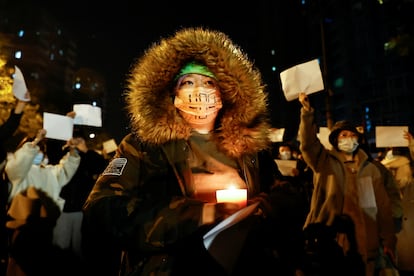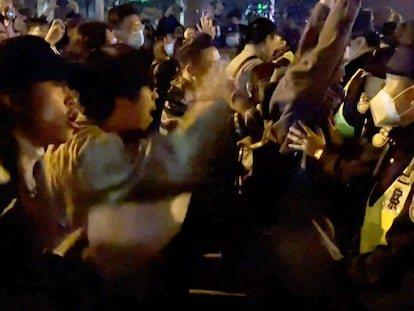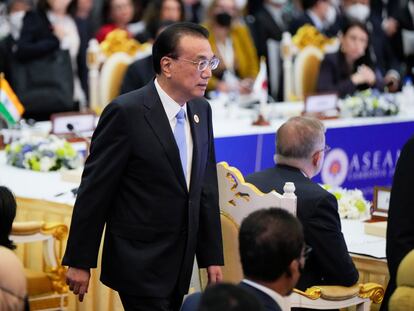Economic havoc, fatal accidents and Covid fatigue: Keys to understanding China protests
Xi Jinping’s decision to continue with a strict zero-covid policy is becoming less popular among large sections of the population, who see other countries adapting to life with the virus

The battle against the coronavirus pandemic has been the chief priority of Chinese President Xi Jinping since the beginning of 2020. The Asian giant is the only major economy on the planet still adhering to a zero-Covid policy, a strategy that has saved millions of lives and allowed the world’s most populous nation to register a tiny number of infections compared to other countries. However, the economic ravages of this policy are weighing more and more heavily on ordinary Chinese and patience after two-and-a-half years of restrictions has worn thin among broad sectors of the population, who have taken to the streets of the country’s largest cities in a rare public protest to demand political changes. The volume of demonstrations across China is extremely unusual and inevitably carries echoes of the student mobilizations of 1989, which led to the Tiananmen massacre.
Many had hoped that after the conclusion of the 20th Congress of the Chinese Communist Party (CCP) in October, the authorities would relax strict sanitary measures. However, in his opening speech at the five-year political event, Xi emphasized the need to continue waging war on Covid-19: “In the face of the sudden outbreak of the novel coronavirus, we have adhered to the supremacy of the people and the supremacy of life, adhered to dynamic zero-Covid [policy], carried out the people’s war, the overall war and defensive war against the epidemic, protected the people’s life safety and physical health to the greatest extent, and achieved major positive results in the overall prevention and control of the epidemic, and economic and social development.”
Low vaccination rates among the elderly - some 267 million people aged over 60 have not received a booster dose - and the weaknesses of its health system are the two main reasons China points to for opting for closures and mass PCR testing at every hint of a flare-up.
To make matters worse the appointment of Li Qiang as number two in the CCP - and as such his probable anointment as the country’s next prime minister - increased doubts over the chances of any opening up in the short-term. Li was the architect of the draconian lockdown in Shanghai, which confined 25 million people in the financial heart of China for two months, sparking widespread discontent.
In addition to general Covid fatigue, a chain of events that occurred over the last 70 days are key to understanding the outbreak of protests across China last weekend. On September 18, 27 people died when a bus taking them to a quarantine center in Guizhou overturned. Celvin Wong (an assumed name), a 30-something publicist from Shanghai, drew a parallel between the crashed vehicle and his country for this newspaper shortly afterward: “We were all on that bus. We all know that the driver is going to the wrong place, but we can’t control the steering wheel. We can’t get off. We are all on a bus called China.”
On October 13, two days before the beginning of the CCP Congress, police arrested a man in Beijing who had hung two banners from a bridge, carrying messages of protest against Xi’s policies: “We do not want PCR tests; we want to eat. We do not want confinement; we want to be free.” It was precisely that phrase that was among the most repeated among the protest that was held Sunday by the banks of the Liangma River in the capital. The arrested bridge protester has not been seen he was detained.
In late October, hundreds of workers fled a Foxconn factory in Zhengzhou over dissatisfaction with strict quarantine measures and living conditions during an outbreak detected inside the facility. During the fiercest waves of the virus, Chinese factories set up a “closed-loop” system, under which employees were not allowed to leave the plant to avoid contagion. This week, wage protests broke out in the same factory, merging with those staged because newly hired workers were being mixed in with some of those infected with Covid. Days earlier, migrant workers in Guangzhou tore down the fences that kept them confined to their blocks and attacked PCR stations in a riot that lasted only 20 minutes but shone a light on the extremely precarious situation facing thousands of workers trying to earn a living.
This atmosphere of simmering tension was exacerbated by the deaths of 10 people in a fire in Urumqi, Xinjiang, on November 24, a tragedy that according to residents could have been avoided if Covid prevention measures had not kept the building semi-confined. A day later, a public official in the region questioned a “lack of knowledge or skills” among residents to get to safety,” comments that caused social networks to explode. Images of demonstrations in Urumqi on November 25 appear to have provided the spark many needed to take to the streets themselves.
Further compounding Xi’s balancing act is that the population is aware other countries have chosen to live with the virus, despite the fact that infections continue. The Chinese president’s meetings with other leaders (and without masks) at the G20 and Asia-Pacific Economic Cooperation summits has generated debate, as has the World Cup in Qatar, which has shown Chinese citizens that the rest of the world has practically returned to pre-pandemic normality.
Sign up for our weekly newsletter to get more English-language news coverage from EL PAÍS USA Edition
Tu suscripción se está usando en otro dispositivo
¿Quieres añadir otro usuario a tu suscripción?
Si continúas leyendo en este dispositivo, no se podrá leer en el otro.
FlechaTu suscripción se está usando en otro dispositivo y solo puedes acceder a EL PAÍS desde un dispositivo a la vez.
Si quieres compartir tu cuenta, cambia tu suscripción a la modalidad Premium, así podrás añadir otro usuario. Cada uno accederá con su propia cuenta de email, lo que os permitirá personalizar vuestra experiencia en EL PAÍS.
¿Tienes una suscripción de empresa? Accede aquí para contratar más cuentas.
En el caso de no saber quién está usando tu cuenta, te recomendamos cambiar tu contraseña aquí.
Si decides continuar compartiendo tu cuenta, este mensaje se mostrará en tu dispositivo y en el de la otra persona que está usando tu cuenta de forma indefinida, afectando a tu experiencia de lectura. Puedes consultar aquí los términos y condiciones de la suscripción digital.
More information
Archived In
Últimas noticias
Most viewed
- Oona Chaplin: ‘I told James Cameron that I was living in a treehouse and starting a permaculture project with a friend’
- Sinaloa Cartel war is taking its toll on Los Chapitos
- Reinhard Genzel, Nobel laureate in physics: ‘One-minute videos will never give you the truth’
- Why the price of coffee has skyrocketed: from Brazilian plantations to specialty coffee houses
- Silver prices are going crazy: This is what’s fueling the rally











































